Quite surely, for people who don’t live in Austria TSV Hartberg is a team which they have never or rarely heard of. That’s logical since this is only their second season in the Austrian top-flight. They finished the last campaign in the 11th position and just two points ahead of Wacker Innsbruck who got relegated.
So, in this season, Hartberg had again the goal to not get relegated and they did fantastically until now as they currently sit in the sixth position. With four more games to go, they are seven points ahead of Austria Vienna who are in the seventh place. After the opening 22 fixtures, the 12 teams get divided in a championship round and a relegation round. If they are able to defend their sixth place in the upcoming four games, they will be part of the championship round which means that they surely can’t get relegated.
In this tactical analysis in the form of a scout report, we’ll look at Hartberg’s tactics and analyse why they are performing so well in this season.
System and players
First of all, you have to mention that when we compare the market values of all 12 teams of the Austrian Bundesliga at this moment, Hartberg have a total market value of £8.17million and sit in this ranking in the 10th position. On the other side, when we look at the average market values per player of the teams, they are in the eighth position with £314k. So, we already see now that Hartberg are clearly in a better position in the league than you would have expected ahead of the season.
Basically, the head coach Markus Schopp always lines his team up in a 4-1-4-1 or 4-2-3-1 formation, but the only difference is the positioning of the three central midfielders. We’ll now look at their most common starting XI and which players usually play.
Rene Swete was in every game except one and in this one match, he was suspended due to a red card. The back four was mostly made of the two centre-backs Felix Luckeneder and Michael Huber and the full-backs Christian Klem and Andreas Lienhart. The central midfield consisted mainly of Bakary Nimaga (more defensive), David Cancola and Rajko Rep (more offensive). On the wings, they usually rotated quite a lot and Stefan Rakowitz, Jodel Dossou, Lukas Ried and Jürgen Heil were the four wingers with the most games while their lone striker and top goalscorer Dario Tadić was in 15 out of 18 games. In the image below we can see, for example, their starting XI (red team) against LASK Linz.
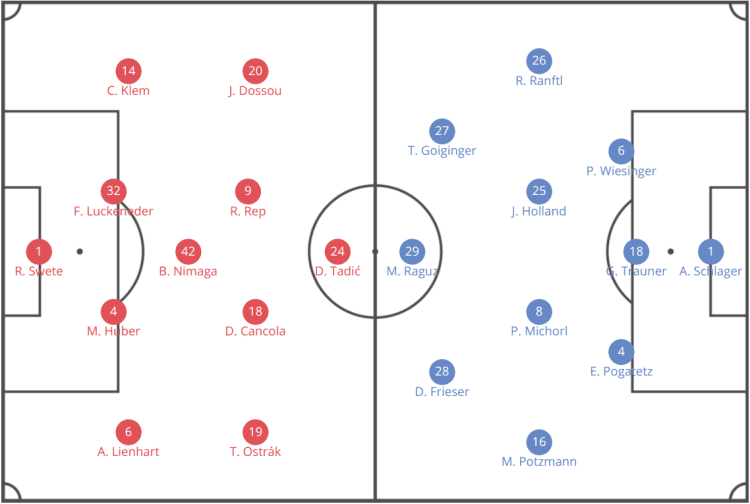
Defending deep as a unit
Before we look now closely at the tactics of Hartberg it’s safe to say that they aren’t a team which like to dominate the game and have the ball for long periods. As we already saw during the comparison of the market values of the teams in the Austrian Bundesliga, the squad of head coach Schopp is one of the underdog teams in Austria. In light of this, in the majority of the matches, they are not the favourites to get the victory. But this changed a bit during this season as they proved that they are able to get good results when they beat Sturm Graz (currently fifth) or got draws against the top teams RB Salzburg and Rapid Vienna.
Because of that aspect, usually, they sit back deeper and let the opposition come at them. Hartberg have on average 45.12% of possession during the 90 minutes and this value already tells us that they like to defend in a low or a mid-block. In these situations, they defend in their 4-1-4-1 or 4-2-3-1 formation and just put pressure on their opponents when they come across the halfway line.
This can be seen in the image below as Cancola (part of the midfield trio) steps out as soon as the player of Salzburg dribbles into the half of Hartberg. This was the only game in this Austrian Bundesliga season so far in which Hartberg used a formation with a back five. However, they still stayed with their tactics that they would defend deep and just get into the duels when the opposition come into their half.
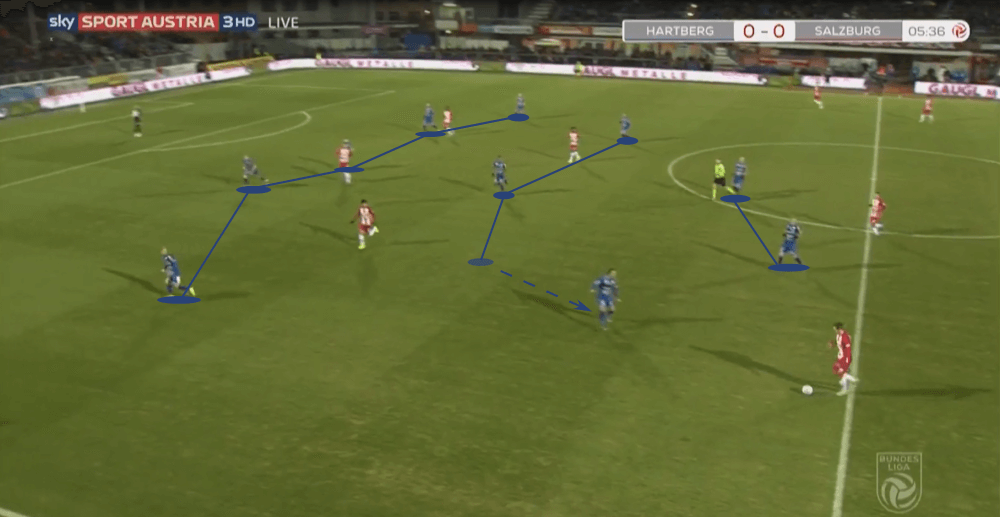
You have to add that their pressing height changes from game to game and also within a match. Generally, it stays around the halfway line but depending on the opposition, the score and the minute of play it changes slightly. So, while the pressing height was about at the halfway line in the game against Salzburg during the opening minutes, in the match against St. Pölten they started to put pressure on the opposition a bit higher up the pitch, as we can see in the first image.
The second shot is from the same game, but it’s the 57th minute and Hartberg are leading 2:0. Due to that, they defend deeper in their own half and let the opposition come at them.
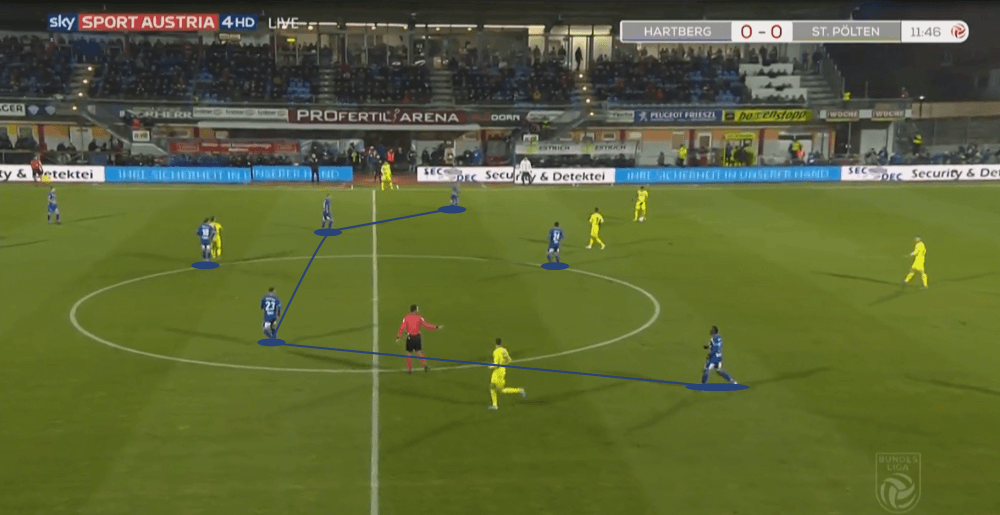
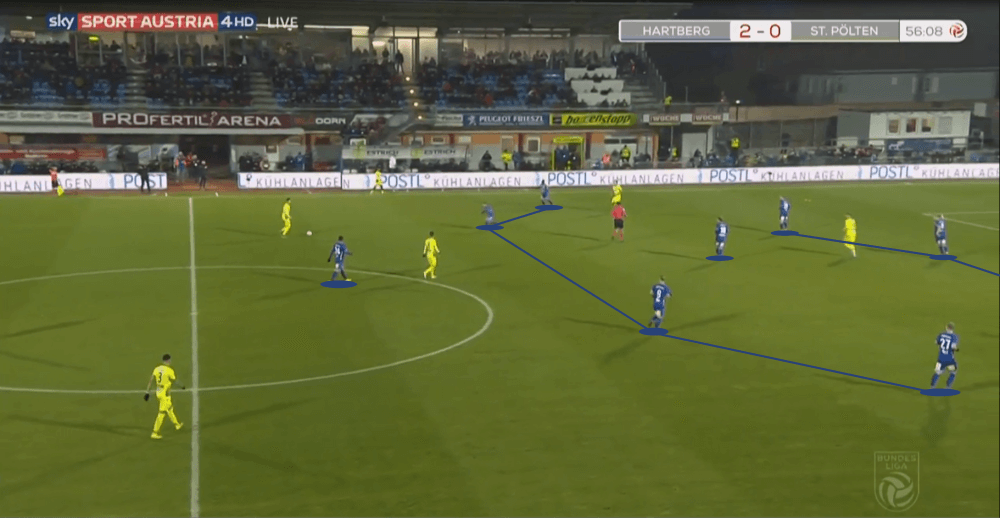
Hartberg’s PPDA (passes per defensive action) sits at 11.16 while the league average is 8.94 and they have the second-highest value. This number shows that Hartberg rarely use a high pressing and also almost never execute a counter-pressing. Of course, they put pressure on the opposition after losing the ball in some situations when they are in a perfect position, but in general, they usually get back in their defensive and deep formation when they lose the ball.
When a team defends so deep it’s important that every single player tries to help the squad by staying in his position and is aware of his defensive duties. Schopp clearly does a great job in this case since his team defends together and as one unit. Often, only the single striker Tadić and one winger stay a bit higher to have forward options for the counter-attacks but we’ll look at this in more detail later in this tactical analysis.
Furthermore, Hartberg try to stay as compact as possible. Especially their horizontal compactness is often quite astonishing as they stay so close to each other to don’t give the opposition any chance to attack through the centre. Their opponents cross on average 20 times per game, which is logical since it’s hard to create goalscoring opportunities through the centre against Schopp’s squad. Especially the back four and the three central midfielders have the task to not offer the opposition any space in the central areas of the pitch, as can be seen in the shot below.
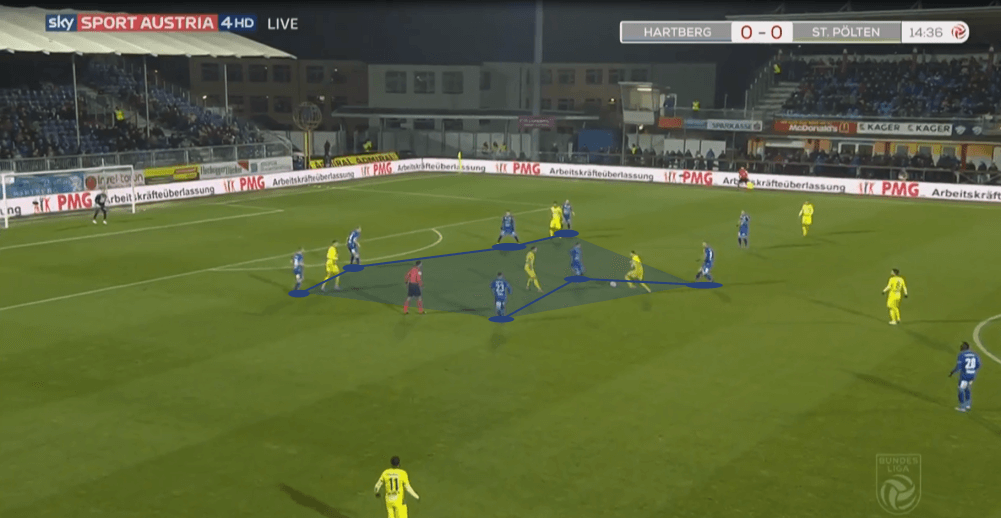
To always keep this compactness alive, the players have to run a lot and permanently shift from one side to the other depending on the position of the ball. Due to that, they are usually permanently able to stay compact and have numerical equality or superiority near the ball. This tactic helps them massively, but at the same time, it has one great risk which some teams already exploited in this season when they played against Hartberg. In the situations when the players of Hartberg shift over to the side where the ball is located, a lot of space appears on the far hand side and their opponents use long diagonal or horizontal passes to exploit that.
In the shot below we can see such an occasion as Austria Vienna play a long ball to switch the side and that creates a one-on-one situation on the opposing wing that leads to a goal for Vienna.
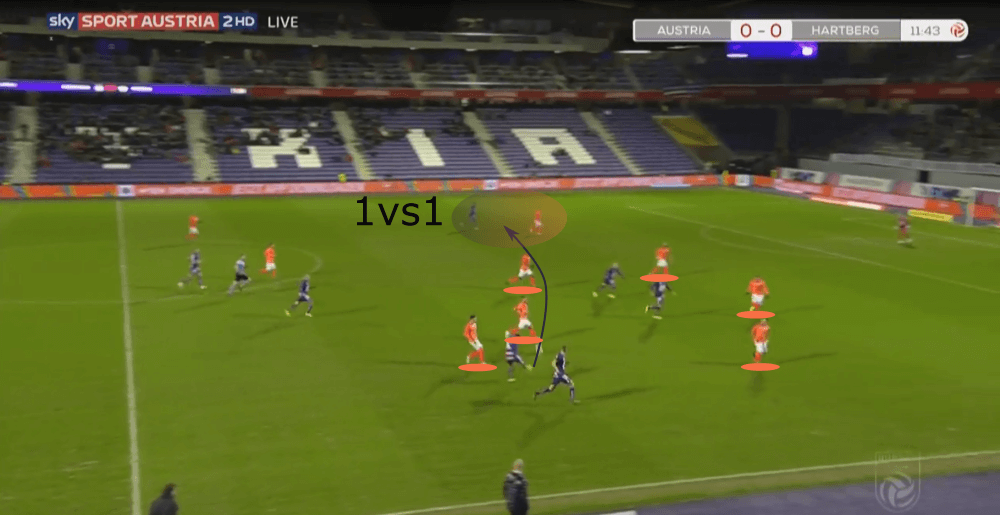
Verticality during the offensive transition
In the paragraph above we saw that Hartberg are usually the team which sits back deeper in a low or mid-block and lets the opposition have the ball for the majority of the time. Due to these aspects, the opponents usually dominate the game and circulate the ball while they progress the attack further up the pitch to reach the final third. In this period, the players of the opposition run forward and position themselves in higher lines, which means that the whole team is positioned high up the pitch.
This is one of the goals of Schopp who wants to lure out the opposition to then exploit the space in their back for counter-attacks. Hartberg average 4.83 counter-attacks per game and this shows that this is one of the tactics on which they rely on. Considering this, as soon as they are able to win the ball back, they want to play it vertically as quickly as possible. That’s logical as they don’t want to give their opposition any time to either start the counter-pressing or to get back in their defensive formation.
In the example below, Hartberg just won the ball from RB Salzburg and the wing-back Heil doesn’t want to play a safe pass into the centre or backwards since he wants his team to get in front of Salzburg’s goal as fast as possible. Due to that, he dribbles to the outside to then play a vertical pass to Ried.
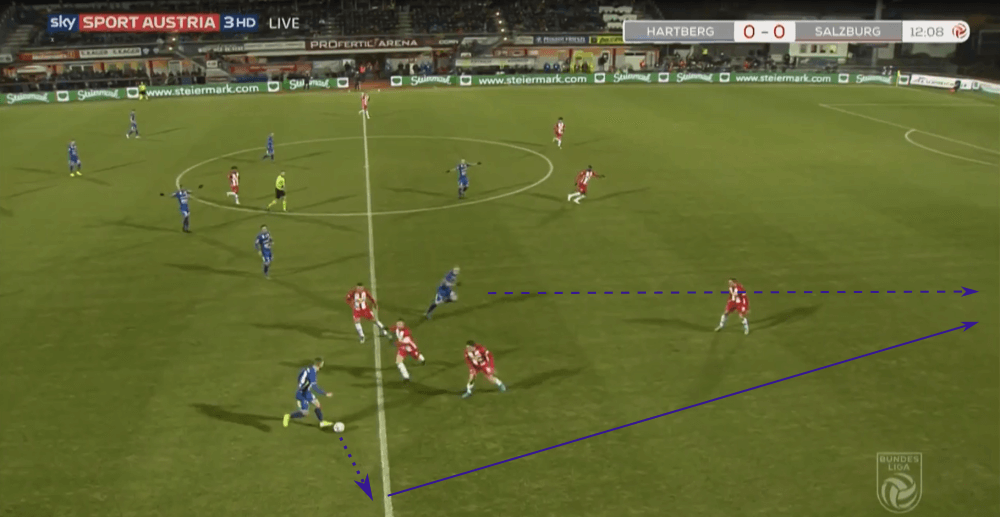
Even though it didn’t work in the situation above, Hartberg’s counter-attacks are usually really dangerous. They still need to work on their efficiency as just 36.9% of their counter-attacks result into a shot, but in general, it’s good to see that the whole team always tries to play vertically as quickly as possible after they won the ball.
In the example below, Cancola intercepted a pass of Salzburg and played a long through pass towards Rep who then scored for the lead.
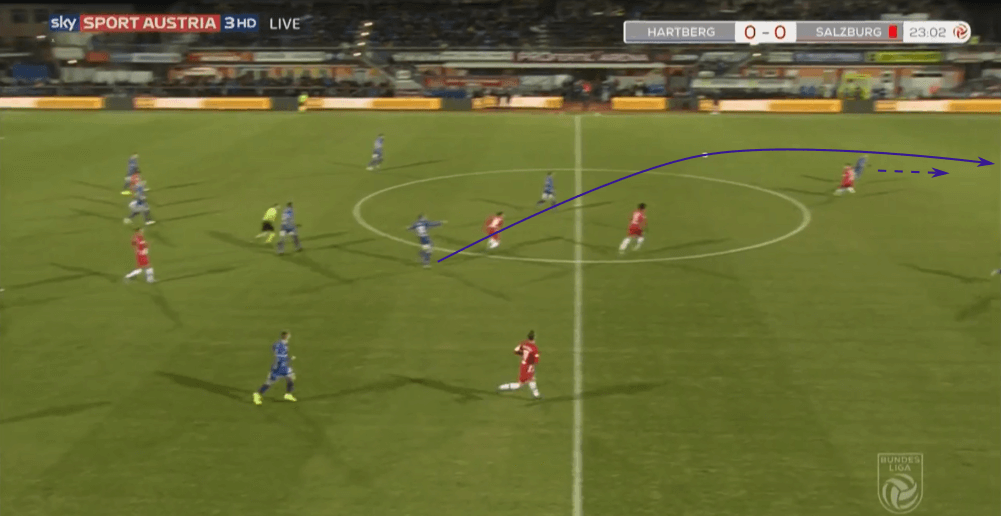
Schopp’s teams also use a specific pattern during the counter-attacks which we’ll see later in this tactical analysis once more as they try to find their striker Tadić with vertical passes which he then lays off for the wingers or central midfielders who rush forward.
This gives the midfield players the chance to sprint forward without the ball and receive it while they are already at full speed and they don’t need to pick it up with the ball at their feet. This can be seen in the example below as Tadić receives a vertical pass during an offensive transition a vertical pass and lays it off for the charging Dossou.
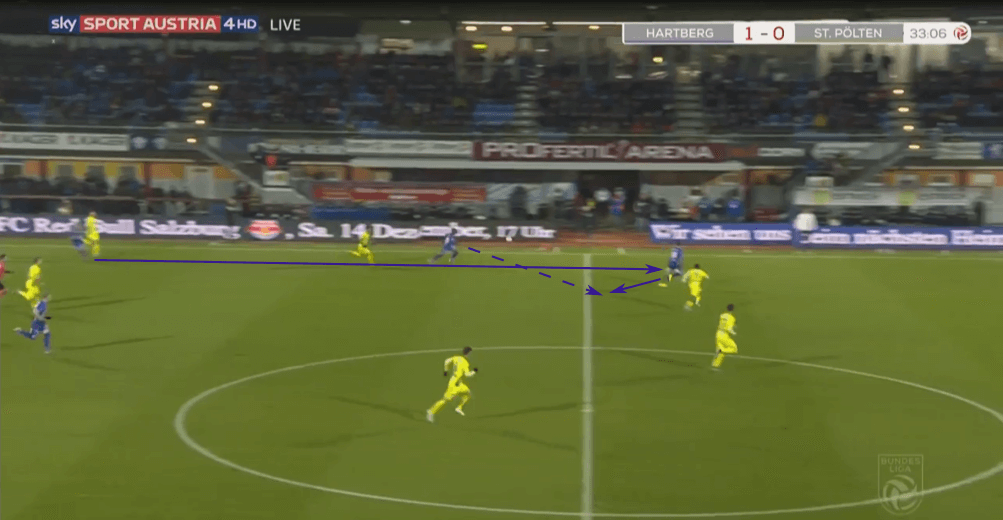
In possession
Even though we already saw in this analysis that Hartberg usually focus on the defending and use counter-attacks to create goalscoring chances, we’ll still look at their build-up. Basically, they average 310.13 passes per game with a success rate of just 76.3% and both values are lower than the league average. So, also the stats tell that they aren’t a team which is that comfortable in possession.
They almost always stay in their respective formation when they are in possession, as can be seen in the image below. The defensive midfielder creates a kind of a triangle with the two centre-backs while the full-backs position themselves extremely wide and they don’t push forward that aggressively during the early stage of the build-up as we often see when teams like Liverpool or Barcelona build up their attacks.
Instead, they stay almost at the same height as the defensive midfielder and start their forward runs later on. The two central midfielders position themselves in the half-spaces to provide vertical passing options through the centre. The positioning of the wingers is not always the same and depends on the players. For example, Dossou likes to move more into the centre while Ried, on the other hand, is a winger who stays mostly wide at the beginning of the build-up.
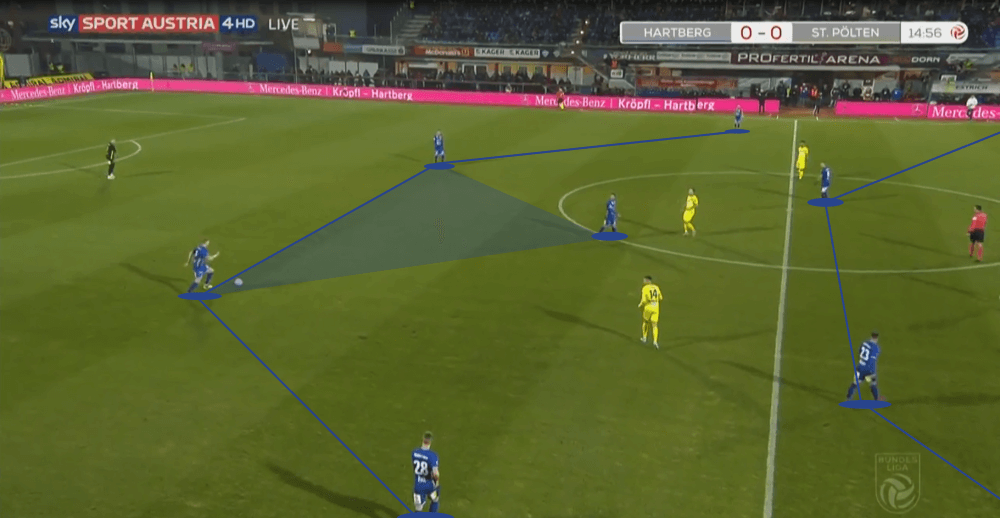
As already noted above, the full-backs usually start their runs when the team were already able to progress the ball further up the pitch, as it can be seen in the example below. They mostly use overlapping runs and stay near the touchline to support the offensive players. Also, it’s the same effect as we saw for the pattern with Tadić: since the full-backs stay deep during the first phase, they then can pick up speed from a deeper position and are already fast when they receive the ball during their overlapping run.
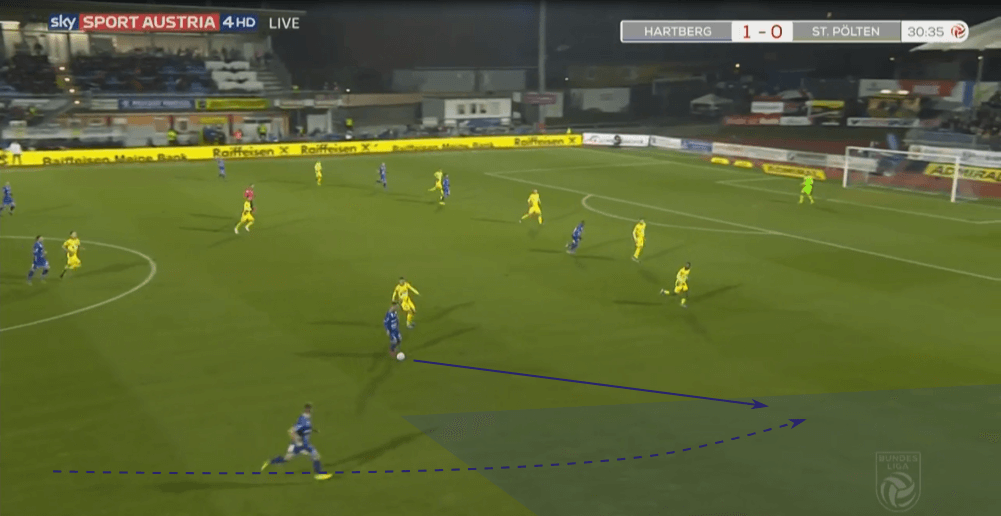
They rarely have an organized build-up with short passes from the back, but if they have, it’s often Rep who is responsible for that. He’s maybe their best player, but surely the strongest on the ball with the most technical abilities. Normally, he’s positioned as one of the central midfielders higher up the pitch and isn’t directly involved during the first phase of the build-up, but sometimes he drops deeper to collect the ball and support his teammates, as can be seen in the image below.
Two opponents are about to put pressure on him while the options for a back pass are marked. Most of his teammates would go for a long ball in this situation, but instead the Slovenian uses a fake shot to turn around and play a pass to the left-back who can exploit the space in front of him.
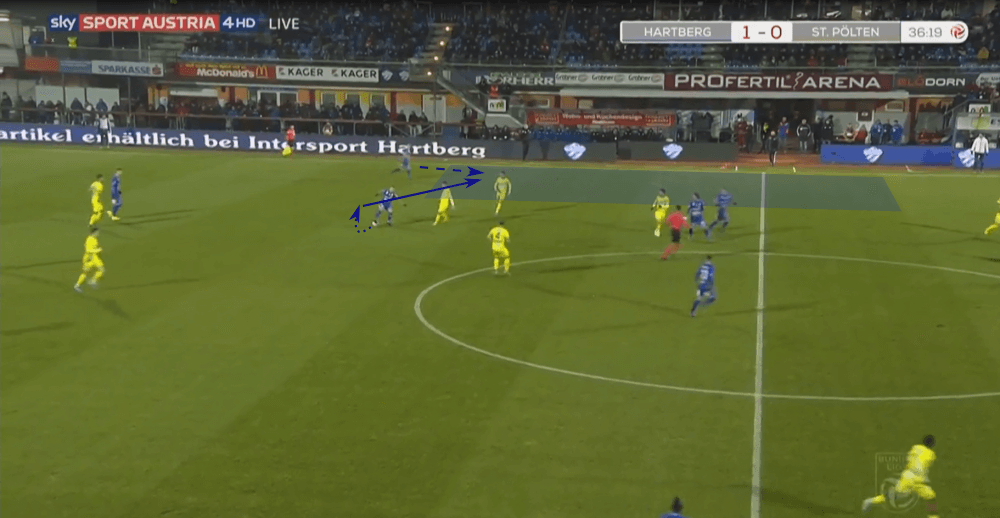
We already saw earlier in this analysis that they often try to find Tadić with vertical balls during the offensive transition and he then lays the ball off for one of his teammates. This pattern also often can be seen during the build-up as the deeper positioned players try to find him with long balls which he then lays off for his teammates. This can be seen in the image below and such actions are also typical for world-class strikers like, for example, Barcelona’s currently injured Luis Suárez.
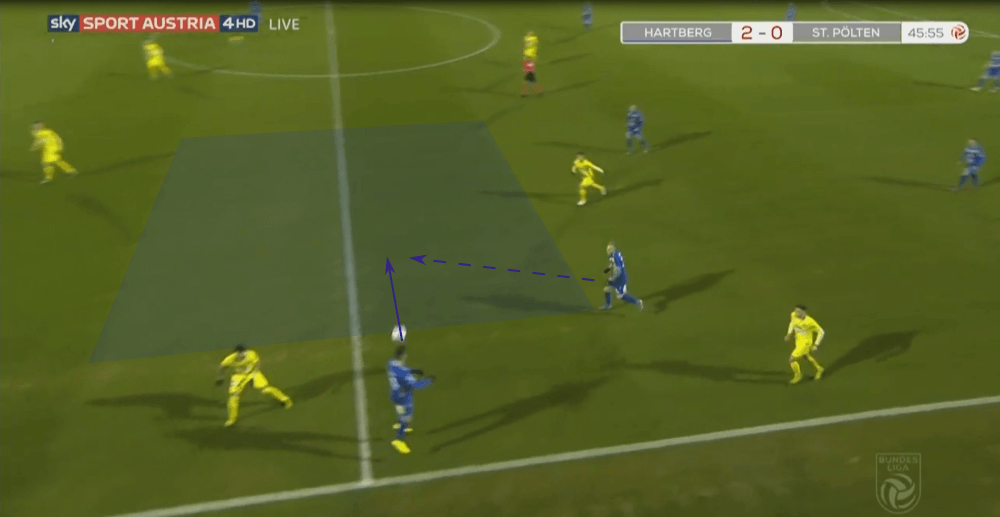
Conclusion
Hartberg are surely not among the very best teams in the Austrian Bundesliga but have already improved massively compared to their last season in which they almost got relegated. Their style of play is indeed not the most attractive one, but it’s really effective as the results tell and Schopp’s team is maybe the surprise of the season in Austria.
It will be interesting to see if they can keep up the level in the remaining games and especially how they will perform in the champions round as there they’ll play against the other five best teams of Austria.





Comments